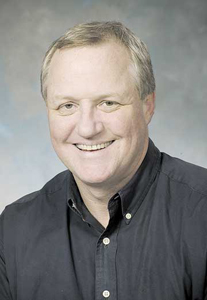Editorial
Front Page - Friday, May 21, 2010
Are We There Yet?
Another time warp
Jay Edwards

I like to think of my behavior in the sixties as a “learning experience.” Then again, I like to think of anything stupid I’ve done as a “learning experience.” It makes me feel less stupid.
– P. J. O’Rourke
I had a birthday this week. Someone once said that if you’re past the age of 11 then it’s probably time to let go of celebrating birthdays. Not sure who came up with that one; probably somebody like Hitler, or Hannibal Lecter.
Well I’m a few years past the age of 11 and I celebrated. Thanks to all who added to the occasion. And thanks again to all my Facebook friends who wished me a happy birthday; even those of you I’ve never heard of.
It says on my Facebook page that I have 169 friends, which sounds like a lot, but in the realm of social-cyber land I’m afraid that number makes me look like some kind of agoraphobic hermit.
Speaking of being age 11, as H.I. McDunnough said so eloquently in Raising Arizona, “Those were the salad days.” For me they were in 1968 and ’69.
The day I turned 11, May 17, 1968, my biggest concerns were probably about riding my bike and the upcoming, always blissful, summer vacation. It was also, however, a time of serious issues, when people just a few years older than me were taking a stand. For instance, on that same day, while I was opening a few presents and likely enjoying one of Mom’s homemade chocolate cakes, on Kent Road in North Little Rock, a group later known as “The Catonsville Nine,” were carrying out their protest of the Vietnam War.
“The Catonsville Nine” were nine Catholic activists who burned draft files to protest the Vietnam War. On that day in mid-May they went to the draft board in Catonsville, Maryland, took 378 draft files, brought them to the parking lot in wire baskets, dumped them out, poured homemade napalm over them, and set them on fire. Looking back, I’m thankful I was born in 1957 and not ’47. Chocolate beats napalm every time.
“If someone thinks that love and peace are cliches that must have been left behind in the Sixties, that’s his problem. Love and peace are eternal.”
– John Lennon
The month before the event in Catonsville, on April 4,
Martin Luther King, Jr. was shot dead at the Lorraine Motel in Memphis. This caused an outbreak of riots in major American cities, which lasted for several days. Two months later police arrested James Earl Ray and charged him as Dr. King’s assassin.
Two months and a day after King died, Sirhan Bishara Sirhan fired a .22 caliber revolver at Senator Robert Kennedy in the Ambassador Hotel in Los Angeles, during a campaign rally, just after Kennedy had finished addressing supporters in the hotel’s main ballroom.
George Plimpton, Rosey Grier, author Pete Hamill, and 1960 Olympic gold medalist Rafer Johnson were among several men who subdued and disarmed Sirhan.
26 hours later, Kennedy’s presidential bid, and his life, came to an end.
Two days before Kennedy was shot, Valerie Jean Solanas waited for Andy Warhol at his New York studio. When he arrived she shot at him three times, hitting him once. Solanas was the author of the SCUM (Society for Cutting Up Men) Manifesto, which encouraged male gendercide and the creation of an all-female society.
She was apparently mad at Warhol because he hadn’t returned a script she’d sent to him.
In September of ’68, France exploded their first hydrogen bomb. I’m not sure if they ever set off another, but fortunately the concept of French Terrorism never took off.
The other day they asked me about mandatory drug testing. I said I believed in drug testing a long time ago. All through the sixties I tested everything.
– Bill Lee
January 20, 1969 – Richard Milhous Nixon succeeds Lyndon Baines Johnson as the 37th President of the U.S.
January 28 – A blowout on Union Oil’s Platform spills 80,000 to 100,000 barrels of crude oil into a channel and onto the beaches of Santa Barbara County in Southern California, inspiring Wisconsin Senator Gaylord Nelson to organize the first Earth Day the following year.
January 30 – The Beatles give their last public performance, on the roof of Apple Records. The police broke up the impromptu concert.
July 17 – The New York Times publicly takes back their 1920 published ridicule of rocket scientist Robert H. Goddard, that spaceflight is impossible.
July 20 – The lunar module Eagle lands on the lunar surface. The world watches as Neil Armstrong takes his historic first steps on the Moon.
If you can remember anything about the sixties, you weren’t really there.
– Paul Kantner
|
|